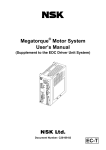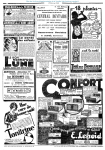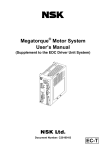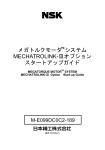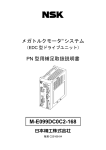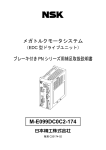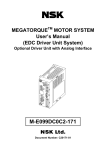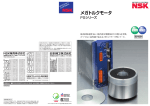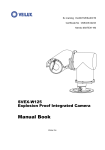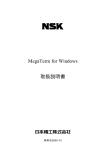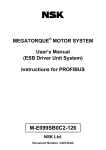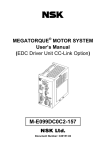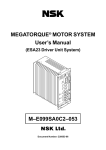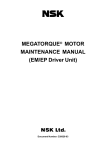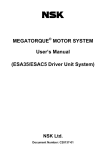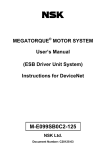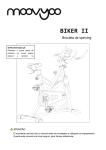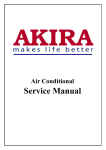Download MEGATORQUE MOTOR™
Transcript
MEGATORQUE MOTOR™ PS Series (Complies with UL Standards and CE Mark) PN Series (Complies with UL Standards and CE Mark) PN Series with Brake Z Series with High Environmental Resistance (Dust-tight, Watertight) Diverse selection of high performance motors with full consideration for safety and the environment The Megatorque Motor draws upon NSK’s combined strengths in manufacturing bearings, sensors and motors. Maximum output torque 200 [N·m] PN4 Motor PNZ4 Motor Outer rotor type The NSK Megatorque Motor’s reliability effectively demonstrates NSK’s full manufacturing and design capabilities. Complete aftercare support is available through our many offices worldwide. The Megatorque Motor boosts productivity and achieves high performance in full compliance with the latest safety standards. Maximum output torque: 180 [N·m] Motor height: 112 [mm] Maximum output torque: 175 [N·m] Motor height: 137 [mm] PN4 Motor PNZ4 Motor PS3 Motor 100 [N·m] Maximum output torque: 90 [N·m] Motor height: 170 [mm] Maximum output torque: 135 [N·m] Motor height: 95 [mm] (models with brake are available) Maximum output torque: 130 [N·m] Motor height: 120 [mm] Comparison of major features PS Series PN/Z Series Outer rotor Inner rotor Small diameter Low profile Fixed from the bottom Fixed from the top High rotational speed High rigidity Small footprint Low motor height Maximum output torque: 60 [N·m] Motor height: 136 [mm] 50 [N·m] PN3 Motor 30 [N·m] PS1 Motor Maximum output torque: 30 [N·m] Motor height: 102 [mm] Compact, clean, high accuracy, hollow structure, minimum maintenance For high-speed positioning of medium/light loads (1) (1) Outer rotor (3) Fixed from the bottom Maximum output torque: 12 [N·m] Motor height: 110 [mm] (1) Inner rotor 10 [N·m] (2) Low profile (3) Fixed from the top (3) (3) Maximum output torque: 12 [N·m] Motor height: 35 [mm] (2) 6 [N·m] Inner rotor type Maximum output torque: 6 [N·m] Motor height: 85 [mm] (3) φ100 1 Maximum output torque: 40 [N·m] Motor height: 100 [mm] PN2 Motor (1) (2) (2) Small diameter Maximum output torque: 45 [N·m] Motor height: 85 [mm] (models with brake are available) Maximum output torque: 15 [N·m] Motor height: 85 [mm] Maximum output torque: 18 [N·m] Motor height: 135 [mm] For positioning of heavy loads PNZ3 Motor φ150 Motor outer diameter φ170 φ210 φ280 2 A direct-drive motor with advanced features only available from NSK With advanced features, including high torque, high resolution, maximum rotational speed of 10 [s–1] (PS Series), high rigidity and compactness, the Megatorque Motor complies with CE mark (PS/PN Series), UL standards (PS/ PN Series), and the EU RoHS directive. These innovative direct-drive motors are extremely accurate, light-weight, and boost the productivity of various devices. High resolution The Megatorque Motor’s absolute position sensor is capable of a high resolution of 2 621 440 [count/revolution] and repeatability of ±2 [arc-sec]. It requires no homing operations and facilitates the development of highly accurate devices. Shortened positioning time A new servo algorithm shortens settling time to less than one-fifth of conventional NSK motors. Shortened positioning time boosts the productivity of various devices. High torque The optimal magnetic field design gives it more than twice as much force density as conventional NSK motors. A maximum of 50% increase in motor torque increases productivity during high acceleration/deceleration drives. Compact motor NSK’s advanced design technology has produced two unique motor series: the low profile PN Series (height of PN2: 35 [mm]) and the light and compact PS Series (outer diameter of PS1: φ100 [mm]). Extensive lineup Resolution of position sensor 2 621 440 [count/revolution] Settling time Less than twice More than Height 35 [mm] (PN2) Outer diameter φ100 [mm] (PS1) Megatorque Motors in a variety of applications and installations • High speed and high accuracy • Compact • Clean • Hollow structure (convenient for wiring/tubing) Application 4: PN Series Automatic part assembly 3 Application 2: PS Series Transport for DVD/CD Application 3: PS Series Inspection conveyor for medical devices • High speed and high accuracy • Clean • Maintenance free • Hollow structure (convenient for wiring/tubing) Application 5: PN Series Turn table and alignment for flat panels • Compact • Clean • Maintenance free Application 6: PN Series + PS Series Manufacturing line for electric parts compliant 90 [arc-sec] • High speed and high accuracy • Compact • Advanced functions (unequal partitioned positioning and short-cut positioning) Application 7: PN Series with Brake Transverse installation Compliance with international safety standards (UL Standards, CE mark) assures worldwide applicability (PS/PN Series). The Megatorque Motor is environment friendly and complies with the EU RoHS Directive. (varies by motor model) IP66M Absolute positioning accuracy Full consideration for people and the environment [s–1] as much High accuracy and interchangeability The EDC Driver Unit’s positioning controller function is provided as a standard feature. In addition, an electronic gear function is built in for setting the pulse train position command. The EDC Megaterm software is used to collect, edit, and monitor data. million [count/revolution] Force density With brake Intelligent 2.62 10 PS Series Maximum rotational speed Application 1: PS Series Inspection equipment for electronic parts 1/5 The product lineup includes the PN Series with brake and the Z Series with High Environmental Resistance (dust-tight, watertight). Interchangeable Motors and Driver Units can be randomly matched. Increased positioning accuracy of 90 [arc-sec] and interchangeability improve ease of use. Resolution of built-in absolute position sensor • Compact • Maintenance free • Advanced functions (fine positioning) • High torque Application 8: PN Series with Brake Installation with external load applied • High-speed • Compact • Maintenance free Application 9: Z Series with High Environmental Resistance Installation for manufacturing automotive components Positioning controller function is a standard feature Compliant with UL Standards, CE mark, EU RoHS Directive • Prevents unwanted rotation • Holds the position • Environmental resistance (environmental protection against water, oil, particulates, etc.) 4 1 Selection Guide PS Series (Outer Rotor Type) PS Series Series 18 (135) Motor height [mm] PN Series Series PS1 Motor Model Maximum output torque [N·m] PN Series (Inner Rotor Type) PS3 Motor PN2 Motor Model Maximum output torque [N·m] 100 [N·m] 90 (170) 50 [N·m] PN3 Motor PN4 Motor 200 [N·m] 18 (135) Motor height [mm] 180 (112) 100 [N·m] 60 (136) 135 (95) 30 [N·m] 50 [N·m] 30 (102) 10 [N·m] 18 (135) 45 (85) 30 [N·m] 15 (85) 12 (110) 6 [N·m] 10 [N·m] 6 (85) Motor outer diameter [mm] Motor hollow diameter [mm] –1 Maximum rotational speed [s ] φ100 φ150 Motor outer diameter [mm] φ35 φ56 Motor hollow diameter [mm] 10 10 Resolution of position sensor [count/revolution] Absolute positioning accuracy [arc-sec] 8 5 –1 Maximum rotational speed [s ] 12 (35) φ170 φ210 φ280 φ36 φ56 φ50 2 3 3 Resolution of position sensor [count/revolution] 2 621 440 2 621 440 Absolute positioning accuracy [arc-sec] 90 (Interchangeable type) (at ambient temperature of 25 ± 5 [°C]) 90 (Interchangeable type) (at ambient temperature of 25 ± 5 [°C]) EDC Driver Unit EDC Driver Unit Driver unit model (Dimensions: W × D × H [mm]) Driver unit model (Dimensions: W × D × H [mm]) 70 × 140 × 190 Reference page Features 5 Motor: 9–12 Shortened positioning time Compact motor Interchangeable, highly accurate absolute position sensor 90 × 140 × 190 Driver unit: 19–24 Compact driver unit Complies with UL Standards and CE Mark 70 × 140 × 190 Reference page Features 90 × 140 × 190 Motor: 13–14 Shortened positioning time Low profile and high rigidity motor Interchangeable, highly accurate absolute position sensor Driver unit: 19–24 Compact driver unit Complies with UL Standards and CE Mark 6 1 Selection Guide PN Series with Brake —Inner Rotor Type PN Series with Brake Series PN3 Motor Model Maximum output torque [N·m] Z Series with High Environmental Resistance—Inner Rotor Type Z Series Series PN4 Motor Maximum output torque [N·m] 200 [N·m] PNZ3 Motor Model PNZ4 Motor 200 [N·m] 100 [N·m] 18 (135) Motor height [mm] 18 (135) 100 [N·m] 135 (111) Motor height [mm] 175 (137) 130 (120) 50 [N·m] 30 [N·m] 40 (100) 50 [N·m] 30 [N·m] 10 [N·m] 45 (97) Motor outer diameter [mm] (flange not included) φ220 φ286 Motor hollow diameter [mm] φ44 φ37 Maximum rotational speed [s–1] 3 3 Resolution of position sensor [count/revolution] 2 621 440 Absolute positioning accuracy [arc-sec] 90 (Interchangeable type) (at ambient temperature of 25 ± 5 [°C]) EDC Driver Unit 10 [N·m] Motor outer diameter [mm] Motor hollow diameter [mm] –1 Maximum rotational speed [s ] Driver unit model (Dimensions: W × D × H [mm]) φ210 φ280 φ32 φ32 3 3 Resolution of position sensor [count/revolution] Absolute positioning accuracy [arc-sec] 90 × 140 × 190 Reference page 2 621 440 90 (Interchangeable type) (at ambient temperature of 25 ± 5 [°C]) EDC Driver Unit Features Motor: 17–18 Shortened positioning time Flat with high rigidity Interchangeable, highly accurate absolute position sensor Ingress Protection (IP) Classification Test under IEC Standards Driver unit model (Dimensions: W × D × H [mm]) Features 7 Compact driver unit Certified with IP rating for dust and water ingress protection Nozzle φ12.5mm 100 /min; 3min Megatorque Motor Z Series with High Environmental Resistance complies with IP66M under IEC standards certified by TÜV Rheinland Japan Ltd. IP6X: Dust-tight test 90 × 140 × 190 Reference page Driver unit: 19–24 Motor: 15–16 Shortened positioning time Flat with high rigidity Interchangeable, highly accurate absolute position sensor Driver unit: 19–24 Compact driver unit Negative actuation type holding brake without backlash IPX6M: Powerful jet test The Z Series was certified with an IP rating after compliance testing under the following two standards: • IEC 60529 Degrees of protection provided by enclosures for electrical equipment (IP code) • IEC 60034-5 Rotating electrical machines—Part 5 The first characteristic numeral of the IP code stands for the degree of protection against ingress of solid foreign objects, such as dust, with “6” (IP6X) indicating completely dust-tight. The second characteristic numeral of the IP code represents the degree of protection against ingress of water (waterproofness), with “6” (IPX6) indicating protection from highpressure (100 /min) water from any angle. A final “M” indicates the watertight test was conducted with a motor rotating. 8 2 Motor Specifications 2.1 PS Series 2.1.1 Reference Number Coding of Motor 2.1.4 Motor Dimensions M-PS1006KN002 2.1.2 Specifications Reference number Functional item M-PS1006KN002 M-PS1012KN002 M-PS1018KN002 φ100 Motor outer diameter [mm] Maximum output torque [N·m] 6 12 Rated output torque [N·m] 2 4 6 85 110 135 Motor height [mm] Motor hollow diameter [mm] φ35 Maximum rotational speed [s ] 10 Rated rotational speed [s–1] 5 –1 Resolution of position sensor [count/revolution] Absolute positioning accuracy [arc-sec] Note 1 2 621 440 ±2 *1 Allowable axial load [N] 1 000 Allowable radial load [N]*2 820 Allowable moment load [N·m] Allowable range of inertia [kg·m2] Mass [kg] Environmental conditions M-PS1012KN002 90 (Interchangeable type) (at ambient temperature of 25 ± 5 [°C]) Repeatability [arc-sec] Rotor inertia [kg·m2] 18 28 0.0024 0.0031 0.0038 0.015 to 0.24 0.03 to 0.31 0.03 to 0.38 2.4 3.5 4.5 Ambient temperature 0 to 40 [°C]; humidity: 20 to 80 [%]; use indoors, free from dust, condensation and corrosive gas. IP30 or equivalent. · Please consult with NSK in case of a simultaneous application of axial load, radial load and moment load to a Motor. · *1 Under no radial load *2 Under no axial load · For an oscillating operation less than 45 [°], turn the Motor 90 [°] or more at least once a day. · Note 1: Absolute positioning accuracy of high-precision products (made to order) is 30 [arc-sec]. (Interchangeable type) (at ambient temperature of 25 ± 5 [°C]) Cable length is up to 8 [m]. · Conditions outside the allowable range of inertia may be applicable, depending on operating conditions. Contact NSK for details. 2.1.3 Rotational Speed and Output Torque Characteristics M-PS1018KN002 1. The bend radius of the motor cable lead (φ7) and the resolver cable lead (φ7) should be R30 [mm] or more. 2. Do not use the leads of the motor cable and the resolver cable with flexing motion. 3. Do not add the stress (tension, vibration, etc.) to the joint of the leads and the connector. It causes the disconnection and the loose connection. 9 10 2 Motor Specifications 2.1.5 Reference Number Coding of Motor 2.1.8 Motor Dimensions M-PS3015KN002 2.1.6 Specifications Reference number Functional item M-PS3015KN002 M-PS3030KN002 Rated output torque [N·m] Motor height [mm] M-PS3030KN002 φ150 Motor outer diameter [mm] Maximum output torque [N·m] M-PS3060KN002 M-PS3090KN002 15 30 60 90 5 10 20 30 85 102 136 170 8 5 φ56 Motor hollow diameter [mm] Maximum rotational speed [s–1] 10 Rated rotational speed [s ] 5 –1 1 Resolution of position sensor [count/revolution] 2 621 440 Absolute positioning accuracy [arc-sec] Note 1 90 (Interchangeable type) (at ambient temperature of 25 ± 5 [°C]) Repeatability [arc-sec] ±2 Allowable axial load [N]*1 2 000 Allowable radial load [N]*2 1 700 Allowable moment load [N·m] Rotor inertia [kg·m2] Allowable range of inertia [kg·m2] Mass [kg] Environmental conditions M-PS3060KN002 42 0.011 0.014 0.019 0.024 0 to 1.1 0 to 1.4 0.12 to 1.9 0.12 to 2.4 5.5 6.9 11.0 13.8 Ambient temperature 0 to 40 [°C]; humidity: 20 to 80 [%]; use indoors, free from dust, condensation and corrosive gas. IP30 or equivalent. · Please consult with NSK in case of a simultaneous application of axial load, radial load and moment load to a Motor. · *1 Under no radial load *2 Under no axial load · For an oscillating operation less than 45 [°], turn the Motor 90 [°] or more at least once a day. · Note 1: A bsolute positioning accuracy of high-precision products (made to order) is 30 [arc-sec]. (Interchangeable type) (at ambient temperature of 25 ± 5 [°C]) Cable length is up to 8 [m]. · Conditions outside the allowable range of inertia may be applicable, depending on operating conditions. Contact NSK for details. 2.1.7 Rotational Speed and Output Torque Characteristics M-PS3090KN002 1. *0.010 for highly accurate upper surface runout type (design serial number: 701) 2. The bend radius of the motor cable lead (φ7) and the resolver cable lead (φ7) should be R30 [mm] or more. 3. Do not use the leads of the motor cable and the resolver cable with flexing motion. 4. Do not add the stress (tension, vibration, etc.) to the joint of the leads and the connector. It causes the disconnection and the loose connection. 11 Regards to inserting pin into rotor pinhole 5. Set tolerance of the inserting pin for clearance fit. 6. Do not apply excessive load and/or impact to the motor when inserting the pin. 7. Use the pinhole as positioning purpose only. Do not use the pinhole to hold the load on rotor. 12 2 Motor Specifications 2.2 PN Series 2.2.1 Reference Number Coding of Motor 2.2.4 Motor Dimensions M-PN2012KN201 2.2.2 Specifications Reference number Functional item Motor outer diameter [mm] Maximum output torque [N·m] Rated output torque [N·m] Motor height [mm] M-PN2012KN201 φ170 (Note 1) φ210 45 135 180 2 15 45 60 85 95 112 φ36 φ56 Maximum rotational speed [s–1] 2 Rated rotational speed [s ] –1 φ280 12 35 Motor hollow diameter [mm] M-PN3045KN001 M-PN4135KN001 M-PN4180KN001 Resolution of position sensor [count/revolution] M-PN3045KN001 φ50 3 1 2 621 440 Absolute positioning accuracy [arc-sec]90 (Interchangeable type) (at ambient temperature of 25 ± 5 [°C]) Repeatability [arc-sec] *1 ±2 Allowable axial load [N] 1 000 4 500 9 500 Allowable radial load [N]*2 300 4 500 9 500 Allowable moment load [N·m] Rotor inertia [kg·m2] Allowable range of inertia [kg·m2] Mass [kg] Environmental conditions 20 0.0024 0.02 to 0.24 80 160 200 0.011 0.057 0.065 0.11 to 0.77 0.57 to 3.99 M-PN4135KN001 0.65 to 4.55 3.7 13 26 31 Ambient temperature 0 to 40 [°C]; humidity: 20 to 80%; use indoors, free from dust, condensation and corrosive gas. IP30 or equivalent. · Please consult with NSK in case of a simultaneous application of axial load, radial load and moment load to a Motor. *2 Under no axial load · *1 Under no radial load · For an oscillating operation less than 45 [°], turn the Motor 90 [°] or more at least once a day. · Note 1: Cable length for PN2012 is up to 8 [m]. ·C onditions outside the allowable range of inertia (about 700 times the rotor’s inertia) may be applicable, depending on operating conditions. Contact NSK for details. 2.2.3 Rotational Speed and Output Torque Characteristics M-PN4180KN001 1. For the dimensions marked *1, extra 3 [mm] margin is required due to their variations. 2. *2 0.010 for highly accurate upper surface runout type (design serial number: 701) 3. The bend radius of the motor cable lead (φ7) and the resolver cable lead (φ7) should be R30 [mm] or more. 4. Do not use the leads of the motor cable and the resolver cable with flexing motion. 5 .Do not add the stress (tension, vibration, etc.) to the joint of the leads and the connector. It causes the disconnection and the loose connection. 13 Regards to inserting pin into rotor pinhole 6. Set tolerance of the inserting pin for clearance fit. 7. Do not apply excessive load and/or impact to the motor when inserting the pin. 8. Use the pinhole as positioning purpose only. Do not use the pinhole to hold the load on rotor. 14 2 Motor Specifications 2.3 PN Series with Brake 2.3.1 Reference Number Coding of Motor 2.3.4 Motor Dimensions M-PN3045KG001 2.3.2 Specifications Functional item Reference number M-PN3045KG001 M-PN4135KG001 φ210 φ280 Maximum output torque [N·m] 45 135 Rated output torque [N·m] 15 45 φ32 φ32 Motor outer diameter [mm] Motor hollow diameter [mm] Maximum rotational speed [s–1] Rated rotational speed [s–1] Resolution of position sensor [count/revolution] Absolute positioning accuracy [arc-sec] 3 1 2 621 440 90 (Interchangeable type) (at ambient temperature of 25 ± 5 [°C])*3 Repeatability [arc-sec] ±2 *3 Allowable axial load [N]*1 4 500 9 500 Allowable radial load [N]*2 4 500 9 500 Allowable moment load [N·m] Brake type Braking torque [N·m] 80 36 Brake power supply [VDC] Brake power consumption [W] Rotor inertia [kg·m2] Allowable range of inertia [kg·m2] Mass [kg] Environmental conditions 160 Negative actuation type holding brake without backlash 72 24 26 0.018 0.11 to 0.77 18 40 M-PN4135KG001 0.080 0.57 to 3.99 34 Ambient temperature 0 to 40 [°C]; humidity: 20 to 80%; use indoors, free from dust, condensation and corrosive gas. IP30 or equivalent. · Please consult with NSK in case of a simultaneous application of axial load, radial load and moment load to a Motor. *2 Under no axial load · *1 Under no radial load · *3 Positioning accuracy with brake released · For an oscillating operation less than 45 [°], turn the Motor 90 [°] or more at least once a day. · Conditions outside the allowable range of inertia (about 400 times the rotor inertia) may be applicable, depending on operating conditions. Contact NSK for details. · User’s manual and technical data are available for brake holding accuracy, operating time, and frequency of use. Contact NSK as necessary. Note on compliance with UL Standards and CE Mark · PN Series with Brake PN Series with brake does not comply with UL Standards or CE Mark. · EDC Driver Unit E DC Driver Units comply with UL Standards and CE Mark when used with a Standard PN Series Megatorque Motor (without brake). However, they do not comply with UL Standards or CE Mark when used with a PN Series Megatorque Motor with a brake. 2.3.3 Rotational Speed and Output Torque Characteristics 1. For the dimensions marked *1, extra 3 [mm] margin is required due to their variations. 2. *2 indicates the minimum lead bend distance. When bending the lead, maintain a greater distance than specified regardless of bend direction. The bend radius of leads should be at least R15 [mm]. 3. Be sure to keep iron powders or oil away from brake surfaces. 4. Iron materials near a brake may interrupt operation; therefore allow for at least 15 [mm] clearance around the brake during installation. 15 16 2 Motor Specifications 2.4 Z Series with High Environmental Resistance 2.4.1 Reference Number Coding of Motor 2.4.3 Rotational Speed and Output Torque Characteristics 2.4.2 Specifications Please refer to 6.7 Effective Torque Calculations to calculate allowable effective torque during positioning operation. Functional item Reference number M-PNZ3040KN001 Motor outer diameter [mm] (without flange) Maximum output torque [N·m] M-PNZ4130KN001 φ220 φ286 40 Rated output torque [N·m] M-PNZ4175KN001 130 175 5 30 45 Motor height [mm] 100 120 137 Motor hollow diameter [mm] φ44 φ37 φ37 Maximum rotational speed [s–1] M-PNZ3040KN001 3 Rated rotational speed [s–1] Resolution of position sensor [count/revolution] 2.4.4 Dimensions 1 2 621 440 Absolute positioning accuracy [arc-sec]90 (Interchangeable type) (at ambient temperature of 25 ± 5 [°C]) Repeatability [arc-sec] *1 ±2 Allowable axial load [N] 4 500 9 500 Allowable radial load [N]*2 4 500 9 500 Allowable moment load [N·m] Rotor inertia [kg·m ] 2 Allowable range of inertia [kg·m2] Mass [kg] M-PNZ4130KN001 80 160 200 0.028 0.12 0.13 0.11 to 0.77 21 0.57 to 3.99 42 0.65 to 4.55 48 Environmental conditions Ambient temperature 0 to 40 [°C]; use indoors, free from corrosive gas Degree of Protection IP66M (IEC/EN 60529, IEC/EN 60034-5) · Please consult with NSK in case of a simultaneous application of axial load, radial load and moment load to a Motor. *2 Under no axial load · *1 Under no radial load · For an oscillating operation less than 45 [°], turn the Motor 90 [°] or more at least once a day. · Please refer to 6.7 Effective Torque Calculations to calculate rated output torque during positioning operation. · Conditions outside of the allowable range of inertia may be applicable, depending on operating conditions. Contact NSK for details. · Dust and water resistance testing do not constitute a guarantee against malfunction or accident, or a guarantee of the product life. IP classifications specified by the IEC constitute indexes for protective performance under fixed conditions, and do not constitute a guarantee of ingress protection in all conditions and for all liquids and solids. · Surface treatment for antirust is applied on the motor outer surface. However it does not mean that NSK guarantees antirust performance in any type of condition/ environment. Please take measures protecting from rust on your own as needed basis. (NSK implemented neutral salt spray test for our surface treatment. Please contact NSK for details.) · Sealing parts, such as oil seals, O-rings and gaskets for connector parts are made of nitrile rubber (NBR). Compatibility with the specific liquid to be used must be confirmed in advance. The operating temperature of the liquid should be 0 to 40 [°C]. Consult with NSK in advance to use the product in environments that it may be exposed to liquid, dust or particulates. · The outer layer sheath of the cable set uses heat resistant PVC, which is not resistant to all types of liquid or oil. Consult with NSK in advance if you are concerned about a specific operating environment or liquids. · Oil seals, O-rings, gaskets, and cables are consumable parts. Periodic inspection of sealing performance is strongly recommended to prevent motor failure or outage due to ingress of water. NSK replaces components, issues an overhaul evaluation report, and conducts performance inspections (excluding operations checking). Charges apply. · Purge the air out of the oil seal section to ensure protection from ingress of water. · Though rust may occur on the motor outer surface, it does not affect the motor performance. Note on compliance with UL Standards and CE Mark · Megatorque Motor Z Series with High Environmental Resistance Megatorque Motor Z Series with High Environmental Resistance does not comply with UL Standards or CE Mark. · EDC Driver Unit E DC Driver Units comply with UL Standards and CE Mark when used with a standard PN Series Megatorque Motor. However, they do not comply with UL Standards or CE Mark when used with a Megatorque Motor Z Series with High Environmental Resistance. 17 M-PNZ4175KN001 1. Do not install in the upside-down position, as liquid will drop to the bottom of the rotating part. 2. Maintain the required space (about 30 [mm]) around the connector part of the motor resolver for fitting. Be sure to install the protective cap (supplied with Motor) when the cable set is not connected, such as during maintenance or inspection. 3. Carefully place and secure the cable set so that bending stress does not occur on the watertight bushing of the cable set to be fitted. 4. The air used for air purging should be dry and at a specified pressure, which can be controlled by connecting a regulator, filter, etc. 18 3 EDC Driver Unit 3.1 Features of EDC Driver Unit System Configuration of PS/PN Series and Z Series with High Environmental Resistance • Adopts new servo algorithm (achieves settling time of 1 [ms]) The EDC Driver Unit adopts an original disturbance observer and preview-based feed-forward control, which significantly reduces the positioning time, especially the settling time (approaching time). • Positioning controller function Positioning operation can be controlled without complicated communication or upper controller. • Compact Driver Unit Combined with special electric components and advanced integration technology, the Driver Unit body is 65% smaller than conventional NSK units. • Variety of control I/Os Control input/output required for positioning is available, including an encoder output, servo control and program control; no additional sensor is required to monitor the status. 3.2 Components and functions of EDC Driver Unit Rear mounting hole 7 segment LEDs indicator Optional mounting bracket available for front mounting. Driver Unit status can be recognized at a glance. Analog monitor output terminal Independent inputs of main power and control power Speed, positioning error, torque, motor current, etc. can be monitored by analog voltage. Effectively used for set up tuning or for monitoring operating status. Separate power lines assure system safety. System Configuration of PN Series with Brake RS-232C communication connector Connect the handy terminal to set parameters. Use the EDC Megaterm software to communicate with a PC. Motor cable connector Clamping type connector shortens work time and prevents mis-wiring. Control I/O connector A variety of signals are available, including servo on, in-position, emergency stop, area signal, override, various alarm outputs, φA/φB/φZ, etc. 3.3 Control Technology and System Configuration of EDC Driver Unit Control Technology and High-speed Positioning Example Disturbance (friction, etc.) • Control block diagram Adopts new servo algorithm Previewbased feedforward controller Position command Settling time: Less than 1 [ms] Feedback controller Torque command + + + – Motor Position output Observer controller Controls to minimize following errors ⇒ Short settling time Controls to negate disturbances ⇒ High servo rigidity • Comparison of 180 [°] positioning Conventional NSK motor (JS2014) 3.4 Example of Brake Sequence PS1012 Motor Positioning time = Command time + Settling time Settling time Following error Positioning time 19 45 [ms] 20 500 pulses 330 [ms] ⇒ ⇒ ⇒ 1 [ms] 40 pulses 147.5 [ms] For brake sequence details, refer to the User’s Manual. 20 3 EDC Driver Units 3.6 Dimensions of EDC Driver Unit (Standard Function) 3.5 EDC Driver Unit Reference Number Used for PS1006 Motor, PS1012 Motor, PS1018 Motor, PS3015 Motor, PS3030 Motor PN2012 Motor EDC Driver Unit for Z Series with High Environmental Resistance is the same unit used with the PN Series. Refer to 9. Motor and EDC Driver Unit Combinations for details of applicable models. Accessories vary depending on the function. Standard accessories (1) CN2 connector (user side) Connector: 54306-5019 (Molex), or equivalent Connector shell: 54331-0501 (Molex), or equivalent (2) CN5 connector (user side) Connector: 231-305/026-000 (WAGO), or equivalent Wiring lever: 231-131(WAGO), or equivalent (3) Mounting bracket (4) User’s Manual (English version) Accessories for EDC Driver Unit (CC-Link Function) (1) CN2 connector (user side) Connector: DHF-PDA10-3-A01-FA (DDK), or equivalent (2) CN5 connector (user side) Connector: 231-305/026-000 (WAGO), or equivalent Wiring lever: 231-131 (WAGO), or equivalent (3) CN6 connector (user side) Connector: MSTB, 5/5-STF-5, 08AU (Phoenix contact), or equivalent Used for PS3060 Motor, PS3090 Motor, PN3045 Motor, PN4135 Motor, PN4180 Motor PNZ3040 Motor, PNZ4130 Motor, PNZ4175 Motor (4) Mounting bracket (5) User’s Manual (English version) (6) User’s Manual for CC-Link (English version) 21 22 3 EDC Driver Units 3.7 General Specifications of EDC Driver Unit Motor model Item Rated capacity [VA] Input power Control power source Main power PS1006 PS1012 PS1018 PS3015 PS3030 PS3060 PS3090 PN2012 PN3045 PN4135 PN4180 300 Maximum capacity [VA] 3.8 Signal Specifications of CN2 (Control I/O) 1 000 400 1 500 500 2 000 500 2 300 800 2 900 400 5 000 600 5 500 100 2 100 500 4400 900 5 000 1100 Input Signal Output Code DC24 5 100 2 621 440 Program operation (up to 256 Program channels: Position commands and parameter settings are programmable) Pulse train command, RS-232C serial communication command, Jogging, Home Return Positioning operation mode Pulse train command Photocoupler input. Maximum frequency: 1 [MHz] Input format: CW/CCW, Pulse and direction or φA/φB Resolution changer for universal multiplication is available (1 000 to 5 242 880 [count/revolution]) Control input Opto-coupler input ([± common], 17 input ports) (Input voltage: 24 [VDC]) Emergency stop, Alarm clear, Over travel limit (+ direction), Over travel limit (– direction), Servo on, Program operation start, Stop, Internal program channel switching 0–7 bit, Jog, Jog direction, (Hold, Velocity, integration OFF, Home Return start, and Home position limit) Input signal Signal format: φA/φB/φZ line driver. Universal resolution setting to φA/φB is available. Resolution of φA/φB: Shipping set: 20 480 [count/revolution] (Quadrupled: 81 920) Maximum: 1 310 720 [count/revolution] (Quadrupled: 5 242 880) *As the maximum frequency is 781 [kHz], the resolution setting limits the maximum velocity. Position feedback signal Output signal Photocoupler output ([± common], 8 outputs) (Max. switching capacity: 24 [VDC] / 50 [mA]) Driver Unit ready, Warning, Over travel limit detection (± direction), Servo state, Busy, In-position, Target proximity A (Target proximity B), Zone A/B/C, Travel limit ±, Normal, Position error under/over, Velocity under/ over, Torque command under/over, Thermal loading under/over, Home return complete, Home position defined Control output RAM error, ROM error, System error, Interface error, ADC error, Emergency stop, CPU error, Position sensor error, Absolute position error, Motor cable disconnect, Excessive velocity, Resolver excitation amplifier alarm, Commutation error, Overheat, Main AC Line over voltage, Excess current, Control AC line under voltage, Power module alarm, Excess position error, Program error, Automatic tuning error, Position command/feedback error, Software thermal error, Main AC Line under voltage, Travel limit over, Field bus warning, Home position undefined, Field bus error Alarms 1, 2 ACLR 4 Alarm clear Clears warning*1 OTP 5 Over travel limit (+ direction) If OTP goes active, the Motor servo is locked in the CW direction*1 OTM 6 Over travel limit (– direction) If OTM goes active, the Motor servo is locked in the CCW direction*1 SVON 7 Servo on If SVON goes active, the servo turns on and the system waits for a command to be entered*1 RUN 8 Start program Starts program operation specified by the PRG input*1 STP 9 Stop Stops positioning operation and execution of the program*1 10 11 Internal program channel selection 0 PRG1 12 Internal program channel selection 1 PRG2 13 Internal program channel selection 2 PRG3 14 Internal program channel selection 3 PRG4 15 Internal program channel selection 4 PRG5 16 Internal program channel selection 5 PRG6 17 Internal program channel selection 6 PRG7 18 Internal program channel selection 7 JOG 19 Jogging If JOG goes active, the Motor rotates. If it goes inactive, the Motor decelerates and stops*1 DIR 20 Jogging direction Specifies the direction of jogging*1 — 21 CW pulse train (+) CWP– 23 CW pulse train (–) CCWP+ 24 CCW pulse train (+) CCWP– 25 CCW pulse train (–) COM 26, 27 Others DRDY Field bus (CC-Link) 90% or less [no condensation] Vibration resistance 4.9 [m/s2] or less Internal functions Regenerative energy absorption Optional regeneration resistor Dynamic brake Functions at power off, servo off and in the occurrence of an alarm. WRN 29 Warning Warns of abnormality in the System*2 OTPA 30 Over travel limit (+ direction) detected Reports the output of over travel limit (software and hardware) in the plus direction *2 OTMA 31 Over travel limit (– direction) detected Reports the output of over travel limit (software and hardware) in the minus direction *2 SVST 32 Servo state Reports states of servo*2 BUSY 33 In-operation Reports state of positioning operation*2 IPOS 34 In-position Reports the condition of positioning error and the positioning operation*2 35 Target proximity A Reports that the Motor is approaching the destination*2 36 Positioning feedback signal φA Output NEARA signal CHA CN1 D-sub 9 pins Standard: Half pitch connector 50 pins CC-Link: Half pitch connector 10 pins CN3 Half-pitch connector 14 pins CN4 Plastic connector (UL and CE compatible) Position sensor Connector Motor Optional regeneration resistor Main/control power source CN5 Plastic connector (UL and CE compatible) CC-Link (option) CN6 Connector MSTB2, 5/5-STF-5, 08 AU (Phoenix contact) Pulse train command rotates the Motor in the CCW direction Reports that the Motor is ready to rotate (The port opens when the Motor is not ready or an alarm occurs) EMI: EN55011, EMS: EN61000-6-2 Pulse train command rotates the Motor in the CW direction Driver Unit ready EMC CN2 — 28 EN50178 Control I/O For a program positioning operation: A combination of ON and OFF of PRG0 to PRG7 inputs specifies channel (0 to 255) to be executed Common for output signal LVD — Output signal common UL Compatible safety regulation CE RS-232C UL508C (Do not connect) 22 Automatic tuning Function set to Input/output ports available Temporal parameter setting by program is available Individual acceleration/deceleration setting Acceleration profiling Operating/Storing humidity (Do not connect) CWP+ RS-232C serial communication (asynchronous, 9 600 [bps]) 0 to 50 [°C] for operating / –20 to +70 [°C] for storing Pin-out — Communication Operating/Storing temperatures PRG0 Input signal External power supply for input signal Terminates positioning operation and the Motor stops by the dynamic brake Analog monitor x 2, (universal range and offset setting), RS-232C monitor Environmental conditions 24 [VDC] external power supply Function EMST 3 Emergency stop Monitors Option Signal Name Single phase 100 to 115 [VAC]/single phase 200 to 230 [VAC] 50/60 [Hz] Single phase 200 to 230 [VAC] 50/60 [Hz] Voltage fluctuation ±10% or less Voltage fluctuation ±10% or less Resolution of position sensor [count/revolution] Pin No. * CHA CHB * CHB 37 Positioning feedback signal *φA 38 Positioning feedback signal φB 39 Positioning feedback signal *φB 40 Positioning feedback signal φZ CHZ 41 Positioning feedback signal *φZ — 42 CHZ * SGND — 43 44 to 50 (Do not connect) Signal ground (Do not connect) A pulse signal that reports the number of rotations of Motors Output format is line driver — Ground for the position feedback signal — Carefully follow these instructions for wiring to CN2. • When wiring to CN2, use shielded wires and a twisted pair for a pulse train input and position feedback output. These wires should be as short as possible (up to 2 [m]). Selection and optional setting of control Input/Output signal functions • You may set signal functions of control Input/Output to any port by the parameters. *1 Input signal • Select up to 16 input signals out of the 22 input signals listed above and then set them to Pin No. 4 to 9 and 11 to 20. (In addition to the Input signals listed above, you may select any of the following signals: Hold, Velocity override, Integration OFF, Home return start, and Home position limit.) • Pin No. 3 is fixed to the “Emergency stop” signal. (The signal polarity is variable.) *2 Output signal • Select up to 7 output signals out of the 23 output signals listed above and then assign them to Pin No. 29 to 35. In addition to the Output signals listed above, you may select any of the following signals: Target proximity B, Zone A/B/C, Over travel limit (± direction), Normal, Position error (under/over), Velocity (under/over), Torque command (under/over), Thermal loading (under/over), Home return completed, and Home position defined. • The output “Driver Unit ready” set to Pin No. 28 can only be replaced with the output signal “Normal.” (Signal polarity cannot be changed.) 23 24 4 5 Cable Set Option 5.1 EDC Driver Unit with CC-Link Function 4.1 Cable Set Reference Number 5.1.1 System Configuration Cable Set Reference Number for PS/PN Series and PN Series with Brake Cable Set Reference Number for Z Series with High Environmental Resistance 4.2 Dimension of Cable Set *NSK Product Cable Set Dimensions for PS/PN Series and PN Series with Brake • The EDC Driver Unit provides the field bus (CC-Link) compatibility. • The station numbers and the baud rate can be set by switches on the Driver Unit’s front panel. • Monitoring communication status by LED, and terminating resistor can be switched on/off. • The EDC Driver Units are fully compatible with CC-Link Ver. 1.10. CN4 Motor side Driver Unit side Input/ Signal Pin Output Code No. CN3 Input signal Cable Set Dimensions for Z Series with High Environmental Resistance M-CXXXWCP14 M-CXXXWCP13 Motor side Motor side 5.1.2 I/O Signal Specifications of CN2 (CC-Link Function) Driver Unit side Function External power supply for input signal 1 — 2 EMST 3 Grey with red dots ACLR 4 Grey with black dots Clear warning OTP 5 White with red dots Over travel limit (+ direction) If OTP goes active, the Motor servo is locked in the CW direction OTM 6 White with black dots Over travel limit (– direction) If OTM goes active, the Motor servo is locked in the CCW direction 7 — DRDY Output signal — COM Driver Unit side Signal Name Cable Color DC24 8 Orange with red dots 24 [VDC] external power supply (Do not connect) Emergency stop (Do not connect) Yellow with black dots Driver Unit ready (Do not connect) 9 10 Pink with black dots Output signal common — Terminates positioning operation and the Motor stops by the dynamic brake — Pin-out Reports that the Motor is ready to rotate (pins are open when the Motor is not ready or when an alarm occurs) — Common for output signal Specifications of Driver Units, except CN2, are the same as standard products (refer to page 24). Cable with CN2 connector (optional) Reference number: M-E011DCCN1-001 Cable bend radius (for both motor cable and resolver cable) 25 Bend radius at fixed side Bend radius at moving side Stationary cable R43 or more — Flexible cable R40 or more R80 or more Driver Unit side 26 5 Option 5.1.3 Dimensions of EDC Driver Unit (CC-Link Function) 5.2 Optional Regeneration Resistor (M-E014DCKR1-100·101) 5.2.1 Dimensions and Schematics M-E014DCKR1-100 Used for PS1006 Motor, PS1012 Motor, PS1018 Motor, PS3015 Motor, PS3030 Motor PN2012 Motor M-E014DCKR1-101 Used for PS3060 Motor, PS3090 Motor, PN3045 Motor, PN4135 Motor, PN4180 Motor PNZ3040 Motor, PNZ4030 Motor, PNZ4175 Motor 5.2.2 Connection to EDC Driver Unit M-E014DCKR1-100 27 M-E014DCKR1-101 28 5 Option 5.3 Handy Terminal 6 Selection of Megatorque Motors To select appropriate Megatorque Motors, examine the following data. 6.1 Loads on the Motor ((1) Load moment of inertia; (2) Axial load, radial load, and moment load; (3) Holding torque required during halts) 6.2 Runout Accuracy 6.3 Positioning Accuracy 6.4 Positioning Time (Index Time) 6.5 Selection of Optional Regeneration Resistor 6.6 Effective Torque Calculations (Example 1) 6.7 Effective Torque Calculations (Example 2) for Z Series with High Environmental Resistance 6.1 Loads on the Motor Handy Terminal FHT21 is an easy-to-handle RS-232C communication terminal for inputting parameters and programs to the EDC Driver Unit. The device can also read and save (upload) driver unit parameters and channel programs, and transmit (download) them to other driver units. • LCD screen: 20 letters × 4 lines, no external power source required, cable length: 3 [m] ((1) Load moment of inertia; (2) Axial load, radial load, and moment load; (3) Holding torque required during halts) (1) Load moment of inertia J When the Megatorque Motor System is used, the size of the moment of inertia of the load mounted to the Motor rotor will significantly affect the acceleration/deceleration characteristics. Thus, calculation of the moment of inertia of the load J is required. (2) Axial load, radial load, and moment load Calculate the load on the Motor. The relationship between external force and load is represented in the following three patterns. Ensure the axial load/radial load and the moment load are set within the allowable axial, radial and moment loads. (Refer to 2. Motor Specifications in this catalog for allowable loads.) Conventional model M-FHT11 is also supported by the EDC Driver Unit. 5.4 RS-232C Communication Cable (Communication cable between EDC Driver Unit and PC) M-C003RS03 (optional) ① When F is an external force: ② When F is an external force: ③ When F is an external force: ● Axial load: Fa = F + total weight of jigs and works ● Axial load: Fa = F + total weight of jigs and works ● Radial load: Fr = F + total weight of jigs and works ● Moment load: M = 0 ● Moment load: M = F × L ● Moment load: M = (F + total weight of jigs and works) × (L + A) Motor model PS1 PS3 PN2 PN3 PN4 Dimension A [mm] 30.2 32.9 16.7 33.8 54.2 PN3 with Brake PN4 with Brake 45.8 70.2 PNZ3 PNZ4 48.8 79.2 (3) Holding torque required during halts When the arm is halted at the position shown at right, the torque, equal to F × L, is applied on the Motor as a load torque. Therefore, limit load torque to equal or below rated torque. When holding brakes, limit load torque to equal or below brake torque. Contact NSK for positioning accuracy for holding brakes. 6.2 Runout Accuracy The measurement method for runout accuracy is shown at right. 6.3 Positioning Accuracy The positioning accuracy of the Megatorque Motor System is considered by two respects as follows: (1) Absolute positioning accuracy: 90 [arc-sec] (interchangeable) (2) Repeatability: ±2 [arc-sec] 29 30 6 Selection of Megatorque Motors 6.6 Effective Torque Calculations (Example 1) [Example 1] We examine the compatibility of the PS Series Motors, assuming a required repeatability of ±0.02 [mm] at 300 [mm] distance from the center. From tanθ=0.02 ÷ 300 θ= tan-1 (0.02 ÷ 300) = 3.8 × 10-3 [°] = 14 [arc-sec] Therefore, ±14 > ±2 Both PS1 and PS3 Models can be used in terms of positioning accuracy. When selecting a Megatorque Motor, it is necessary to consider the maximum required torque and the effective torque required for the actual operation. Determine whether 90 [°] can be positioned in 0.24 [s], assuming the load moment of inertia is 0.05 [kg·m2]. Also calculate the effective torque when an operation cycle is 0.3 [s]. Conditions: 6.4 Positioning Time (Index Time) When a Megatorque Motor is used to index an angle, index times can be roughly calculated as follows. [kg·m2] Jm: Load moment of inertia [kg·m2] Jr : Rotor moment of inertia N : Rotational speed of the Motor [s–1] T : Output torque at the rotational speed N [N·m] [N·m] Tm: Load torque [s] t1 : Travel time [s] t2 : Settling time [s] t3 : Positioning time t: Accelerating/decelerating time [s] θ : Rotational angle [°] η : Safety coefficient (normally 1.4-1.5) In accordance with the list above, • Since the rotational acceleration is 25 [s–2], calculate the approximate required torque using the following equation. Equations: T: Torque at accelerating [N·m] Jm: (Load moment of inertia [kg·m2]) = 0.05 [kg·m2] Jr: (Rotor moment of inertia [kg·m2]) = 0.019 [kg·m2] α: Rotational acceleration [s–2] = 25 [s–2] η: Safety coefficient = 1.4 Required torque at accelerating/decelerating T = (Jm + Jr) ×α = (0.05 + 0.019)×2π×25 = 10.8 [N·m] Therefore, the candidate selection is a motor with a maximum output torque of 15.2 [N·m] (obtained by multiplying required torque by a safety factor of 1.4) or larger. The PS1 Model (excluding PS1006 and PS1012), PS3 Model, PN3 Model, or PN4 Model can be selected. Note: Since the moment of inertia of the rotor of the motor varies depending on the motor, the required torque needs to be recalculated for each motor. Please refer to the following table for the settling time. Since the settling time will also be affected by factors such as the magnitude of the moment of inertia of the load and rigidity of the whole structure, the settling time is not absolute. Required repeatability [arc-sec] Maximum rotational speed = 2.5 [s–1] Rotational acceleration = 25 [s–2] Repeatability = ±15 [arc-sec] Dwell time = 0.06 [s] Jm (load moment of inertia) = 0.05 [kg·m2] Jr (rotor moment of inertia) = 0.019 [kg·m2] (for PS3060) • The effective torque required for the actual operational pattern in use (see following diagram) needs to be examined. Also determine whether the PS3060 meets the operational conditions. t: accelerating/decelerating time = 0.1 [s], t2 : settling time = 0.04 [s], t3 : dwell time = 0.06 [s], t4 : cycle time = 2 × t + t2 + t3 = 0.3 [s] Settling time t2 [s] ±2 to ±10 0.1 ±10 to ±100 0.04 ±100 and above 0.001 6.5 Selection of Optional Regeneration Resistor (1) Obtain rotational energy of Megatorque Motor during deceleration Calculate the rotational energy using the following equation: Jr : Rotor inertia [kg·m2] Rotational energy= 1/2 × J × ω2 [J] 2 Jm: Moment of inertia of the load [kg·m2] = 1/2 × J × (2πN) [J] N : Rotational speed [s-1] J= Jr + Jm Required effective torque Rotational energy = 1/2 × (Jm + Jr) × (2πN)2 = 1/2 × (0.05 + 0.019) × (2π× 2.5)2 = 8.5 [J] An effective torque of 11.4 [N·m] is determined by multiplying the equation above by a temperature coefficient of 1.3, which is less than the PS3060’s rated output torque of 20 [N·m]. Therefore, the PS3060 sufficiently meets the operational conditions and no optional regeneration resistor is necessary. • In case results do not meet rated torque ≥ effective torque, recalculation with revised conditions is required. (2) Regenerative energy capacity by internal capacitors The regeneration energy that can be charged by the internal capacitors is 28 [J]. (3) Calculate energy consumed by optional regeneration resistor Energy consumed by optional regeneration resistor [J] = Rotational energy [J] – 28 [J] (capacitor absorption energy) When the difference is zero or less, no optional regeneration resistor is necessary. When the difference is greater than zero, use the following procedure to obtain the required capacity for an optional regeneration resistor. (4) Calculate required capacity for optional regeneration resistor Required capacity for an optional regeneration resistor [W] = Energy consumed by optional regeneration resistor [J] / (Operation cycle [s] × 0.25) 0.25: Load ratio of optional regeneration resistor use When the quotient is 7 or less, use optional regeneration resistor: M-E014DCKR1-100. (optional) When the quotient is 120 or less, use optional regeneration resistor: M-E014DCKR1-101. (optional) Please contact NSK when the quotient exceeds 120. 31 32 6 Selection of Megatorque Motors 7 6.7 Effective Torque Calculations (Example 2) for Z Series with High Environmental Resistance When selecting a Megatorque Motor, it is necessary to consider the maximum required torque and the allowable effective torque required for the actual operation. Determine whether 90 [°] can be positioned in 0.24 [s], assuming the load moment of inertia is 0.05 [kg·m2]. Also calculate the effective torque when an operation cycle is 0.3 [s]. Conditions: Maximum rotational speed = 2.5 [s–1] Rotational acceleration = 25 [s–2] Repeatability = ±15 [arc-sec] Dwell time = 0.06 [s] Jm (load moment of inertia) = 0.05 [kg·m2] Jr (moment of inertia of the rotor) = 0.12 [kg·m2] (for PNZ4130) Ti = Internal load torque = 15 [N·m] T: Torque at accelerating [N·m] α: Rotational acceleration [s–2] = 25 [s–2] Jm: (Load moment of inertia) = 0.05 [kg·m2] η: Safety coefficient = 1.4 Jr: (Rotor moment of inertia) = 0.12 [kg·m2] Required torque at accelerating/decelerating T = (Jm + Jr) × α = (0.05 + 0.12) × 2π × 25 = 26.7 [N·m] The positioning time for Megatorque Motors is calculated in accordance with “6.3 Positioning time.” When dwell time is relatively longer than accelerating/decelerating time (dwell time > accelerating/decelerating time x 10), rough positioning time can be determined using the following positioning time diagrams. These diagrams only apply under the following conditions. (1) The motor is directly connected to the load (without gear reducer, belt, or couplings), and the rigidity of the load is sufficiently high (natural frequency: More than 100 [Hz]). (2) No load torque is applied to the motor. The following conditions require additional considerations. a. When the load’s moment of inertia exceeds the allowable moment load and is off the diagram: Operation is possible, although much more time may be required than shown in the diagram, since rotational speed and acceleration are limited. • Since the rotational acceleration is 25 [s–2], calculate the approximate required torque using the following equations. Equations: Positioning Time Diagrams Allowable effective torque [N·m] Internal load torque [N·m] M-PNZ3040KN001 15 10 M-PNZ4130KN001 45 15 M-PNZ4175KN001 60 15 b. When there is no diagram for the relevant positioning angle: An appropriate calculation is required. No calculation, however, is effective for very small angles. Settling time of 0.001 [s] has been included. Add more settling time when higher repeatability is required. Example: Motor: PN4180 Moment of inertia: 3.0 [kg·m2] Index angle: 45 [°] Minimum positioning time of 0.3 [s] is determined according to the line in the following diagram. Required repeatability [arc-sec] Settling time [s] ±2 to ±10 0.1 ±10 to ±100 0.04 ±100 and above 0.001 Therefore, the candidate selection is a motor with a maximum output torque of 37.4 [N·m] (obtained by multiplying required torque by a safety factor of 1.4) or larger. The PNZ3 Model or PNZ4 Model can be selected. Note: Since the moment of inertia of the rotor of the motor varies depending on the motor, the required torque needs to be recalculated for each motor. • The effective torque required for the actual operational pattern in use (see following diagram) needs to be examined. Also determine whether the PNZ4130 meets the operational conditions. t = accelerating/decelerating time = 0.1 [s], t2 : settling time = 0.04 [s], t3 : dwell time = 0.06 [s], t5 : constant speed time = 0 [s], t4 : cycle time = 2 × t1 + t2 + t3 + t5 = 0.3 [s] Effective torque Rotational energy = 1/2 × (Jm + Jr) × (2πN)2 = 1/2 × (0.05 + 0.12) × (2π × 2.5)2 = 21.0 [J] An effective torque of 32.5 [N·m] is determined by multiplying the equation above by a temperature coefficient of 1.3, which is less than the PNZ4130’s allowable effective torque of 45 [N·m]. Therefore, the PNZ4130 sufficiently meets the operational conditions and no optional regeneration resistor is necessary. • In case results do not meet allowable effective torque ≥ effective torque, recalculation with revised conditions is required. 33 34 8 Installation 8.1 Installation of Motor 8.2 Dummy Inertia • Install and secure the Motor on a rigid base, otherwise mechanical vibrations may occur. •M ount the motor using the tapped or through-holes. •T he mounting surface flatness should be less than 0.02 [mm]. •T he Motor can be attached either horizontally or vertically. (For Z Series with High Environmental Resistance, do not install in the upside-down position.) •T ake care not to push up the underside cover when attaching the motor. (PS Series) •P lease see below figure for counterbore depth from base top. (PS Series) •T he bend radius of the motor cable lead and the resolver cable lead should be R30 [mm] or more. Do not use the leads of the motor cable and the resolver cable with flexing motion. For the full use of the benefits of the direct drive motor system, it is essential to maximize the resonance frequency of the whole mechanism by increasing the rigidity of the load, as well as securely fastening the Motor to a highly rigid mechanical system. Therefore, adding some dummy load to the rotor directly may help in the following cases. A. A key is used to fix the load to the rotor because the load cannot be directly attached to the rotor. B. The load is directly fixed to the rotor. However, vibration occurs due to torsional deflection on the rotary axis of the load. C. Inertia of the whole mechanism is very low when a thin shaft such as a ball screw shaft is attached. D. T here exists play because a sprocket chain or a gear train is used. E. V ibration occurs because the rigidity of the structure is low, such as when the Motor is being used for driving a belt. • Inertia of a dummy load shall be approximately 20% of the load inertia. When a speed reducer mechanism is used, it shall be GD21/(r2 × GD2d) ≤ 5 Where GD21 = inertia of indirectly connected load, GD2d = inertia of directly attached load, and r = reduction ratio. When inserting the PS Series connector through the bottom of the base, making a larger hole than is shown in this figure is recommended. Note: If the motor is installed as indicated in the figure below, mechanical vibrations will be generated and the velocity loop proportional gain (VG) cannot be increased. It will occur overshoot and the motor can not operate smoothly. • Attach the load directly to the motor rotor. • Mount the motor directly to the base. 35 8.3 Installation of Driver Unit • The EDC Driver Unit must be fixed so that fins are in the vertical position for natural air-cooling. • Ambient temperatures should be in a range from 0 to 50 [°C]. The Driver Unit cannot be used in excess of 50 [°C]. A sufficient space of at least 100 [mm] should be provided both above and below the Driver Unit in a control cabinet. • Operate the Driver Unit in an environment in which internally generated heat can be dissipated. If heat is trapped above the Driver Unit, open the space above it to allow for the heat to dissipate (in this case, also take steps to prevent the entry of dust) or provide a forced-air cooling system. • Use the Driver Unit in a control cabinet with IP54 or higher. Protect the Driver Unit from exposure to oil mist, cutting water, cutting dust, coating gas, etc., to prevent their entry into the Driver Unit through ventilation openings, which may cause circuit failure. • When installing two or more Driver Units for multi-axis combinations, provide a 10 [mm] or more space between adjacent Driver Units. • The Driver Unit can be attached to a panel using front mounting brackets (optional). • The maximum power loss of the EDC Driver Unit is 55 [W]. 36 9 Motor and EDC Driver Unit Combinations 9.1 PS Series and EDC Driver Unit Combinations Motor Outer Diameter Reference Number Coding of Motor M-PS1006KN002 φ 100 M-PS1012KN002 EDC Driver Unit Reference Number (** indicates accessories specification) Power Voltage [VAC] Cable Reference Number 100 to 115 200 to 230 M-PN4135KG001 M-EDC-PN4135AB502-** 200 to 230 M-PN3045KG001 φ 210 M-EDC-PN3045ABC02-** 200 to 230 M-EDC-PN3045CBC02-** 100 to 115 φ 220 M-EDC-PN4135ABC02-** 200 to 230 200 to 230 M-EDC-PS1018CB502-** 100 to 115 M-EDC-PS3015AB502-** 200 to 230 M-EDC-PS3015CB502-** 100 to 115 M-EDC-PS3030AB502-** 200 to 230 M-C***SCP13 M-EDC-PS3030CB502-** 100 to 115 M-EDC-PS3060AB502-** 200 to 230 M-EDC-PS3060CB502--** 100 to 115 M-EDC-PS3090AB502-** 200 to 230 100 to 115 M-C***SCP03 (Stationary cable) *** indicates 002: 02 [m] 100 to 115 M-EDC-PS1012ABC02-** 200 to 230 M-EDC-PS1012CBC02-** 100 to 115 M-PS1018KN002 M-EDC-PS1018ABC02-** 200 to 230 008: 08 [m] M-EDC-PS1018CBC02-** 100 to 115 010: 10 [m] M-EDC-PS3015ABC02-** 200 to 230 015: 15 [m] M-EDC-PS3015CBC02-** 100 to 115 020: 20 [m] M-EDC-PS3030ABC02-** 200 to 230 030: 30 [m] M-EDC-PS3030CBC02-** 100 to 115 M-PS3030KN002 φ 150 M-PS3060KN002 M-PS3090KN002 M-EDC-PS3060ABC02-** 200 to 230 M-EDC-PS3060CBC02-** 100 to 115 M-EDC-PS3090ABC02-** 200 to 230 M-EDC-PS3090CBC02-** 100 to 115 Reference Number Coding of Motor (** indicates accessories specification) Power Voltage [VAC] φ 170 M-PN2012KN201 M-EDC-PN2012AB502-** 200 to 230 M-EDC-PN2012CB502-** 100 to 115 φ 210 M-PN3045KN001 M-EDC-PN3045AB502-** 200 to 230 M-EDC-PN3045CB502-** 100 to 115 M-PN4135KN001 M-EDC-PN4135AB502-** 200 to 230 M-PN4180KN001 M-EDC-PN4180AB502-** 200 to 230 φ 170 M-PN2012KN201 M-EDC-PN2012ABC02-** 200 to 230 M-EDC-PN2012CBC02-** 100 to 115 φ 210 M-PN3045KN001 M-EDC-PN3045ABC02-** 200 to 230 M-EDC-PN3045CBC02-** 100 to 115 M-PN4135KN001 M-EDC-PN4135ABC02-** 200 to 230 M-PN4180KN001 M-EDC-PN4180ABC02-** 200 to 230 φ 280 φ 280 37 EDC Driver Unit Reference Number EDC Driver Unit Reference Number (** indicates accessories specification) M-PNZ4130KN001 004: 04 [m] 005: 05 [m] M-EDC-PN3045AB502-** 200 to 230 M-EDC-PN3045CB502-** 100 to 115 M-EDC-PN4135AB502-** 200 to 230 M-EDC-PN4180AB502-** 200 to 230 M-EDC-PN3045ABC02-** 200 to 230 M-EDC-PN3045CBC02-** 100 to 115 φ 220 M-PNZ3040KN001 003: 03 [m] Cable Reference Number φ 286 M-PNZ4130KN001 M-EDC-PN4135ABC02-** 200 to 230 φ 286 M-PNZ4175KN001 M-EDC-PN4180ABC02-** 200 to 230 M-C***WCP13 (Flexible cable, straight connector) M-C***WCP14 (Flexible cable, angle connector) ***indicates cable length. 006: 06 [m] CC-Link function 256 program channels Cable Reference Number Main Specifications 256 program channels Refer to 9.1. (Maximum cable length for PN2012 is 8 [m].) Pulse train input (Photocoupler) CC-Link function 256 program channels Pulse train input (Photocoupler) CC-Link function 256 program channels Power Voltage [VAC] M-PNZ4175KN001 9.2 PN Series and EDC Driver Unit Combinations Motor Outer Diameter φ 286 001: 01 [m] 200 to 230 Reference Number Coding of Motor φ 220 M-PNZ3040KN001 cable length. Refer to 9.1. Main Specifications 9.4 Z Series with High Environmental Resistance and EDC Driver Unit Combinations Motor Outer Diameter M-EDC-PS1006ABC02-** M-PS3015KN002 Pulse train input (Photocoupler) M-PN4135KG001 (Flexible cable) M-EDC-PS1006CBC02-** M-PS1012KN002 φ 100 256 program channels Cable Reference Number Power Voltage [VAC] M-EDC-PN3045CB502-** M-EDC-PS1018AB502-** M-PS1006KN002 (** indicates accessories specification) φ 280 M-PS1018KN002 M-EDC-PS3090CB502-** EDC Driver Unit Reference Number 100 to 115 M-EDC-PS1006CB502-** 100 to 115 M-PS3090KN002 Reference Number Coding of Motor 200 to 230 M-EDC-PS1012CB502-** M-PS3030KN002 φ 150 M-PS3060KN002 Motor Outer Diameter M-EDC-PN3045AB502-** 200 to 230 M-PS3015KN002 Main Specifications φ 210 M-PN3045KG001 M-EDC-PS1006AB502-** M-EDC-PS1012AB502-** 9.3 PN Series with Brake and EDC Driver Unit Combinations 002: 2 [m] 004: 4 [m] 006: 6 [m] 008: 8 [m] 010: 10 [m] 015: 15 [m] 020: 20 [m] 030: 30 [m] Main Specifications 256 program channels Pulse train input (Photocoupler) CC-Link function 256 program channels 9.5 Options Reference number Contents M-E014DCFS1-001 CN2 connector (user side) for standard function Connector M-E014DCFS1-006 CN2 connector (user side) for CC-Link function M-E014DCFS1-002 CN5 connector (user side) M-E014DCFS1-003 CN6 connector (user side) M-E050DCKA1-001 Driver Unit mounting brackets M-E099DC0C2-155 User’s Manual (Japanese version) Manual M-E099DC0C2-158 User’s Manual (English version) M-E099DC0C2-156 CC-Link option instruction manual (Japanese version) M-E099DC0C2-157 CC-Link option instruction manual (English version) Optional regeneration resistor M-E014DCKR1-100 Optional regeneration resistor ( 7 [W] ) M-E014DCKR1-101 Optional regeneration resistor ( 120 [W] ) Accessory set M-E014DCFS1-004 Set of M-E014DCFS1-001, M-E014DCFS1-002, and M-E050DCKA1-001 RS-232C Communication Cable M-C003RS03 Cable with CN2 connector M-E011DCCN1-001 Handy Terminal M-FHT21 Item Mounting bracket Communication cable between PC and EDC driver unit (Cable length: 3 [m]) Cable with CN2 connector for CC-Link function (Cable length: 3 [m]) RS-232C interface terminal for inputting parameter/program into EDC driver unit (Cable length: 3 [m]) 256 program channels 38 10 “EDC Megaterm” Application Software 11 Once installed on your computer, this software enables the editing, preparation and control of EDC Driver Unit programs and parameters. It also facilitates the allocation and monitoring of control input/output. And its oscilloscope function allows for easy confirmation of Motor operation. EDC Megaterm can be downloaded for free from the NSK Web site (http://www.nsk.com/). Personal computer RS-232C communication cable is available (option). Type: M-C003RS03 (cable length: 3 [m]) RS-232C EDC Megaterm EDC Driver Unit Windows 2000 • XP• Vista • A USB port can be used on a PC without a COM port. In this case, use a commercial RS-232C/USB conversion adaptor for communication. We have confirmed the compatibility of the SRC06-USB, USB serial cable made by Arvel. • The RS-232C communication connector for the EDC Driver Unit has a different pin configuration than that for a PC. 2. Allocation and monitoring of control input/output 3. Parameter editing CE Marking (PS/PN Series only) • Low voltage command (applicable standard: EN50178) The Megatorque Motor PS/PN Series is incorporated into machinery as components. NSK set low voltage standards to ensure the Megatorque Motor PS Series fully complies with the EC Directive. The standards have been certified by TÜV, a third-party testing and certification organization. • EMC command (applicable standards: EMI EN55011 and EMS EN61000-6-2) NSK defined installation models (conditions) for the Megatorque Motor PS/PN Series, including installation space and wiring between Driver Units and Motors, and set EMC command standards based on 4 [m] cable models, which have been certified by TÜV. When Megatorque Motor PS/PN Series is incorporated into machinery, real-world installation and/or wiring conditions may differ from those of established models. Therefore, it is necessary to check for EMC command compliance (especially radiation and conduction noise) in the machinery incorporating the PS/PN Series Motors. Compliance with UL Standards (PS/PN Series only) Functions 1. Oscilloscope function International Safety Standards and Warranty Information 5. Others: •U pload/download parameter and channel data • Terminal 4. Channel editing • Motor UL Recognized Component Compliant with UL1004-1 (File No.: E216970) • Driver Unit Compliant with UL508C (File No.: E216221) • Cable set UL-compliant cables are used Warranty Period • The warranty period is either one year from delivery or 2 400 hours of operation, whichever comes first. Limited Warranty Main Functions 1. Oscilloscope function • 4-channel oscilloscope, 10 [k sampling/s] maximum • Anything that can be monitored using the handy terminal can be displayed on the oscilloscope. • Monitor scales are adjustable. • Measured waveforms are output as bitmaps or CSV format. 3. Parameter edits arameter edits take effect in real time (off-line editing is P also supported) • Parameter-by-parameter reset to default • Help function for parameters • Report of parameter setting list • • The warranty is limited to the products supplied by NSK Ltd. • The defective products will be repaired free of charge within the applicable warranty period. • Repairs after the expiration of the applicable warranty period will be subject to payment. Immunities • The product is not warranted in one of the following cases even within the warranty period. • Failure of the unit due to installation and operation not in accordance with the instruction manual specified by the supplier. • Failure of the unit due to improper handling and use, modification and careless handling by the user. • Failure of the unit due to the causes other than those attributable to the supplier. • Failure of the unit due to modification or repair that is conducted by a person(s) or party (ies) other than the supplier. • Other types of failures due to natural disasters and accidents (causes not attributable to the responsibility of the supplier). • Damages induced by a failure of the supplied unit are not covered. Services Fee 2. Allocation and monitoring of control input/output llocation of control input/output by drag-and-drop A editing • Monitoring of input/output signals • Report of allocation list • 4. Channel edits Drag-and-drop edits from command window Direct input capability also supported (automatic insertion of comments) • Report of program list • • • Prices of goods do not include any applicable service charges, such as the dispatching of engineers. • Startup or maintenance services that require the dispatching of engineers are subject to payment even during the applicable warranty period. • Service charges will be invoiced in accordance with the supplier’s standard service charge list. Discontinuation of Production and Maintenance Service Period • Any discontinuation of production will be announced one year in advance. The maintenance service period is five (5) years after discontinuation of production. Announcement will be released by the supplier or published on the NSK Web site. Special-purpose Applications his product is intended for general industrial applications and is not designed or manufactured for use under dangerous T conditions. • Contact NSK before using this product for any special-purpose applications, including nuclear power equipment and systems or aerospace, medical, and safety devices. • While this product is manufactured under strict quality controls, NSK recommends that an appropriate safety device be installed when used with equipment that could cause serious accidents or damage in the event of product failure. • 39 40 12 Form for Requesting Megatorque Motor Selection To be completed by customer NSK will assist in selecting the optimal Megatorque Motor. Please fill in the necessary items on the below form and send it by fax to the local NSK office. Items marked with Example of completed form represent the important information required for selection. Please provide as much detail as possible. Date (DD/MM/YYYY): To Company Name: / Date (DD/MM/YYYY): 12 / 01 / 2010 To Mr. XXX XXX , in charge of Precision Machinery & Parts, NSK / Section: Engineering Dept., Engineering Section #1 Company Name: YYY Corporation Section: Contact: Contact: TEL Name: FAX Application and equipment used Application and equipment used (specify with as much detail as possible) (specify with as much detail as possible) Upright position Motor installation position (check in Horizontal position Upside-down position Others Motor installation position ) (check in Output shaft in a vertical direction Load conditions (1) Geometry, dimensions, thickness, material (or mass) of table (2) Dimensions, mass, quantity of loads/ jigs (3) PCD (distance between the jigs/ loads) (example of description) (Example) Output shaft in a horizontal direction TEL 03-1234-5678 Name: YYY YYY Semiconductor inspection machine Upright position Horizontal position Upside-down position Output shaft in a vertical direction Load conditions (1) Geometry, dimensions, thickness, material (or mass) of table (2) Dimensions, mass, quantity of loads/ jigs (3) PCD (distance between the jigs/ loads) (example of description) (Example) Output shaft in a horizontal direction Output shaft in a downward direction Schematic drawing (an attached illustration showing outside dimensions is acceptable) • Please provide information on outside dimensions, dimensions from the center, material, etc. φ 300 φ 250 20 mm Material: Aluminum Jig • Jig: M ass of 5 kg x 4 PCD: 250 mm • External force: None Table Attachment: N (4) External force (pressure/impact load, sliding friction, etc.) None Always At settling During rotating Rotational direction Sliding friction Yes No Some impact Attachment: (4) External force (pressure/impact load, sliding friction, etc.) *Specify position, direction, etc. in the schematic drawing. Motor size requested Internal program system Index angle / Number of points Repeatability (±) Settle at ± Pulse train input operation RS-232C operation CC-Link mm at Positioning command system Index angle / Number of points °, Number of points: seconds (± 10 N None Always At settling During rotating Rotational direction Sliding friction mm from the motor center) Repeatability (±) Cycle pattern Cycle pattern (desired positioning time) *Specify settling time. (desired positioning time) *Specify settling time. Environmental conditions 100 to 115 [VAC] 200 to 230 [VAC] Operating environment Operating temperature Contact NSK for details. Cable specification and length Other request items 41 Others ( No Some impact Force is applied downward to a single point at 125 mm in radius from the center. M-PS3060 Internal program system Pulse train input operation [VAC]) General environment (equivalent to IP30) Oil, water and chemical Chips and dust Clean 0°C to 40°C Below 0°C Above 40°C Other ( °C) Stationary cable Flexible cable Length: m Select “Movable” when cable is repeatedly bent anywhere along the wiring route. Input power voltage Environmental conditions Other request items CC-Link ± 20.6 seconds (± 0.01 mm at 100 mm from the motor center) 100 to 115 [VAC] 8 1.0 200 to 230 [VAC] Operating environment Operating temperature Contact NSK for details. Cable specification and length RS-232C operation Settle at 90 °, Number of points: 4 0.7 Input power voltage Yes *Specify position, direction, etc. in the schematic drawing. Motor size requested Positioning command system Others ) Output shaft in a downward direction Schematic drawing (an attached illustration showing outside dimensions is acceptable) • Please provide information on outside dimensions, dimensions from the center, material, etc. FAX 03-1234-5678 Others ( [VAC]) General environment (equivalent to IP30) Oil, water and chemical Chips and dust Clean 0°C to 40°C Below 0°C Above 40°C Other ( °C) Stationary cable Flexible cable Length: 4 m Select “Movable” when cable is repeatedly bent anywhere along the wiring route. Please reply by January 12, 2010. (example) 42 MEGATORQUE MOTOR™ PS Series (Complies with UL Standards and CE Mark) PN Series (Complies with UL Standards and CE Mark) PN Series with Brake Z Series with High Environmental Resistance (Dust-tight, Watertight) Diverse selection of high performance motors with full consideration for safety and the environment























